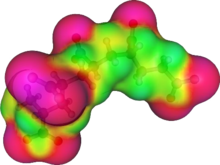

COSMO[1][2] (COnductor-like Screening MOdel) is a calculation method for determining the electrostatic interaction of a molecule with a solvent. COSMO is a dielectric continuum model[1][3][4][5] (a.k.a. continuum solvation model). These models can be used in computational chemistry to model solvation effects. COSMO has become a popular method of these solvation models in recent years. The COSMO formalism is similar to the method proposed earlier by Hoshi et al.[1][6] The COSMO approach is based – as many other dielectric continuum models – on the surface segmentation of a molecule surface[3] (usually referred to as 'solvent accessible surface' SAS approach).
Continuum solvation models – such as COSMO – treat each solvent as a continuum with a permittivity . Continuum solvation models approximate the solvent by a dielectric continuum, surrounding the solute molecules outside of a molecular cavity. In most cases it is constructed as an assembly of atom-centered spheres with radii approximately 20% larger than the Van der Waals radius. For the actual calculation the cavity surface is approximated by segments, e.g., hexagons, pentagons, or triangles.
Unlike other continuum solvation models, COSMO derives the polarization charges of the continuum, caused by the polarity of the solute, from a scaled-conductor approximation. If the solvent were an ideal conductor the electric potential on the cavity surface must disappear. If the distribution of the electric charge in the molecule is known, e.g. from quantum chemistry, then it is possible to calculate the charge on the surface segments. For solvents with finite dielectric constant this charge is lower by approximately a factor :
The factor is approximately
where the value of should be set to 0.5 for neutral molecules and to 0.0 for ions, see original derivation.[2] The value of is erroneously set to 0 in the popular C-PCM reimplementation of COSMO in Gaussian.
From the thus determined solvent charges and the known charge distribution of the molecule, the energy of the interaction between the solvent and the solute molecule can be calculated.
The COSMO method can be used for all methods in theoretical chemistry where the charge distribution of a molecule can be determined, for example semiempirical calculations, Hartree–Fock-method calculations or density functional theory (quantum physics) calculations.[1]
- ^ a b c d A., Klamt; G., Schüürmann (1993). "COSMO: a new approach to dielectric screening in solvents with explicit expressions for the screening energy and its gradient". J. Chem. Soc. 2 (5). Perkin Trans.2: 799–805. doi:10.1039/P29930000799.
- ^ a b Klamt, Andreas (2005). From Quantum Chemistry to Fluid Phase Thermodynamics and Drug Design. Boston, MA, USA: Elsevier. ISBN 9780444519948.
- ^ a b Herbert, John M. (2021-03-23). "Dielectric continuum methods for quantum chemistry". WIREs Computational Molecular Science. 11 (4). arXiv:2203.06846. doi:10.1002/wcms.1519. ISSN 1759-0876. S2CID 233629977.
- ^ Cramer, Christopher J. (2004). Essentials of computational chemistry: theories and models (2nd ed.). Chichester, West Sussex, England: Wiley. ISBN 0-470-09182-7. OCLC 55887497.
- ^ Frank, Jensen (2017). Introduction to computational chemistry. John Wiley & Sons. ISBN 978-1-118-82599-0. OCLC 989360916.
- ^ Hoshi, Hajime; Sakurai, Minoru; Inoue, Yoshio; Chûjô, Riichirô (1987-07-15). "Medium effects on the molecular electronic structure. I. The formulation of a theory for the estimation of a molecular electronic structure surrounded by an anisotropic medium". The Journal of Chemical Physics. 87 (2): 1107–1115. Bibcode:1987JChPh..87.1107H. doi:10.1063/1.453343. ISSN 0021-9606.






